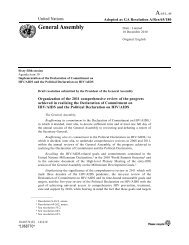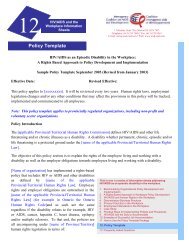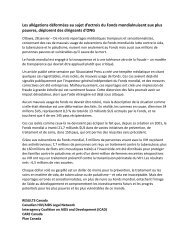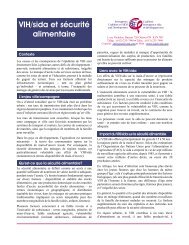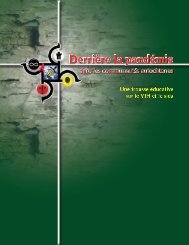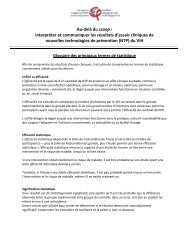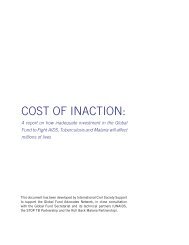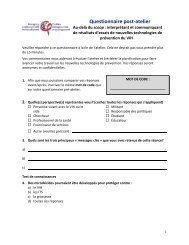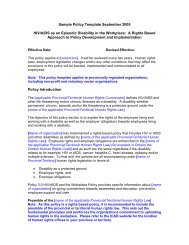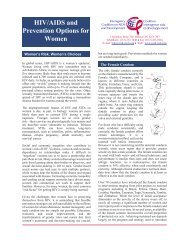Facilitator’s Note:These backgroundnotes providefur<strong>the</strong>r <strong>in</strong>formation on<strong>the</strong> historical, social,cultural, political, andeconomic factors thataffect HIV vulnerabilityamong Aborig<strong>in</strong>alpeoples and communities.You can use this<strong>in</strong>formation to support<strong>the</strong> conversations withparticipants dur<strong>in</strong>gStages 2 – 5.Background Notes for Facilitators: Fur<strong>the</strong>r <strong>in</strong>formation on factors affect<strong>in</strong>gHIV vulnerability and impact among Aborig<strong>in</strong>al peoplesMany factors affect <strong>the</strong> likelihood that an Aborig<strong>in</strong>al person will be exposed to <strong>the</strong> HIVvirus and that affect <strong>the</strong>ir ability to live well once <strong>in</strong>fected:The personal circumstances – or <strong>the</strong> social, physical and economic environments - <strong>in</strong>which a person grew up and lives <strong>the</strong>ir daily life affect <strong>the</strong> likelihood that <strong>the</strong>y willengage <strong>in</strong> behaviours that may expose <strong>the</strong>m to HIV as well as <strong>the</strong>ir ability to stay healthyonce <strong>in</strong>fected. These <strong>in</strong>clude whe<strong>the</strong>r a person has or can get <strong>the</strong> th<strong>in</strong>gs <strong>the</strong>y need tolive comfortably such as education, employment, health care, decent hous<strong>in</strong>g, food, andclean water; whe<strong>the</strong>r <strong>the</strong>y feel that <strong>the</strong>y belong to and are valued and respected by <strong>the</strong>ircommunity; whe<strong>the</strong>r <strong>the</strong>y are able to take part <strong>in</strong> society; and whe<strong>the</strong>r <strong>the</strong>y haveexperienced traumatic life events such as childhood abuse, sexual or physical assault, orbeen taken away from <strong>the</strong>ir family and placed <strong>in</strong> <strong>the</strong> child welfare system.The everyday lives of Aborig<strong>in</strong>al peoples are affected by <strong>the</strong> general socio-economic,cultural and environmental conditions <strong>in</strong> Canada. This <strong>in</strong>cludes broad issues like<strong>the</strong> economic and social policies of our governments, <strong>the</strong> performance of <strong>the</strong> globaleconomy, <strong>the</strong> design of our neighbourhoods and <strong>the</strong> health of our environment.Many of present day challenges and <strong>in</strong>justices faced by Aborig<strong>in</strong>al peoples are a result ofsystemic and structural <strong>in</strong>equalities related to colonization, racism, entrenched poverty,and historical trauma. These <strong>in</strong>equalities are a result of <strong>the</strong> unjust nature of <strong>the</strong> politicaland economic systems <strong>in</strong> a society and <strong>the</strong>y affect a particular group of people as awhole.While Aborig<strong>in</strong>al peoples are disproportionately affected <strong>in</strong> Canada’s HIV epidemic,it is important to recognize that not all Aborig<strong>in</strong>al peoples are at risk of HIV <strong>in</strong>fection.Some people are more vulnerable than o<strong>the</strong>rs as a result of o<strong>the</strong>r forms of social andeconomic exclusion related to gender, race, sexual orientation, and ability.As well, Aborig<strong>in</strong>al peoples and communities have <strong>in</strong>dividual, family, community, andcultural strengths that provide a protective buffer from vulnerability. Resiliency is <strong>the</strong>ability of <strong>in</strong>dividuals and communities to “bounce back” from and cope with stressfuland challeng<strong>in</strong>g circumstances better than expected.The factors <strong>in</strong> diagram 1 reflect <strong>the</strong> Public Health Agency of Canada’s (PHAC)determ<strong>in</strong>ants of health. The National Aborig<strong>in</strong>al Health Organization (NAHO) hasidentified additional factors – called <strong>the</strong> broader determ<strong>in</strong>ants of Aborig<strong>in</strong>al health- that contribute to present day <strong>in</strong>justices and health disparities faced by Aborig<strong>in</strong>alpeoples. PHAC has identified twelve determ<strong>in</strong>ants of health that affect <strong>the</strong> healthof Canadians and contribute to health <strong>in</strong>equities, <strong>in</strong>clud<strong>in</strong>g <strong>in</strong>come and social status,education, employment and work<strong>in</strong>g conditions, social support networks, healthychildhood development, social environments, physical environments, personal practicesand cop<strong>in</strong>g skills, biology and genetics, health services, gender, and culture. The broaderdeterm<strong>in</strong>ants <strong>in</strong>clude colonization, globalization, migration, cultural cont<strong>in</strong>uity, access,territory, systemic poverty, and self-determ<strong>in</strong>ation.80
Colonization• Indigenous peoples globally have a shared history of colonization which ischaracterized by exclusion, separation from <strong>the</strong>ir territories, bann<strong>in</strong>g of spiritualpractices, isolation and stripp<strong>in</strong>g of political power, all <strong>in</strong>tended to remove <strong>the</strong>ir<strong>in</strong>dividual and collective identities.• Colonization can be understood as <strong>the</strong> unequal relationship between <strong>the</strong> Stateand Indigenous peoples, result<strong>in</strong>g <strong>in</strong> paternalistic policies, <strong>in</strong>sufficient <strong>in</strong>vestments<strong>in</strong> <strong>in</strong>frastructure and separation from socio-political and spiritual resources. Thedirect consequence is <strong>in</strong>dividual and collective damage, forced poverty, and culturaldisruption.• Aborig<strong>in</strong>al peoples’ systems of governance, education, health care and justice wereviewed as <strong>in</strong>ferior and replaced with <strong>in</strong>compatible systems based on Europeanvalues and methods.• The residential school system is a key example of colonization <strong>in</strong> Canada. The federalgovernment and churches used residential schools as a tool to force First Nations,Inuit and Métis children to conform to European/Western norms and lifestyles.Residential schools were an emotional weapon used aga<strong>in</strong>st Aborig<strong>in</strong>al peoples as away to break <strong>the</strong>ir spirit, family and community systems.• Ano<strong>the</strong>r important example is <strong>the</strong> forced relocation of Inuit <strong>in</strong> nor<strong>the</strong>rn Canada from<strong>the</strong>ir home communities <strong>in</strong> <strong>the</strong> 1930-40s to establish a Canadian presence <strong>in</strong> remotelocations, cutt<strong>in</strong>g <strong>the</strong>m off from traditional territories and Inuit cultural practicesthat established resilience and order with<strong>in</strong> <strong>the</strong>ir world.• When health services are framed <strong>in</strong> a ma<strong>in</strong>stream perspective/approach, <strong>the</strong>y ignore<strong>the</strong> collective history of oppression and violence experienced by Aborig<strong>in</strong>al peoplesand do not <strong>in</strong>clude Aborig<strong>in</strong>al forms of recovery and heal<strong>in</strong>g that <strong>in</strong>corporate moreholistic approaches to wellness.Poverty• Poverty affects people’s life circumstances, such as <strong>the</strong> k<strong>in</strong>d of hous<strong>in</strong>g <strong>the</strong>y live <strong>in</strong>,<strong>the</strong>ir access to food and clean water, and <strong>the</strong>ir ability to do well <strong>in</strong> school.• In many societies, people liv<strong>in</strong>g <strong>in</strong> poverty are judged and made to feel ashamed;<strong>the</strong>y are blamed for <strong>the</strong>ir liv<strong>in</strong>g situation and viewed as lazy, uneducated and tak<strong>in</strong>gadvantage of social support.• This deprivation and stigma can affect people’s choices. Cuts to social support bygovernments mean lower benefits for social assistance – even as rent and food costs<strong>in</strong>crease – leav<strong>in</strong>g s<strong>in</strong>gle parents with <strong>in</strong>adequate resources to feed <strong>the</strong>ir childrenand pay <strong>the</strong> rent. Some vulnerable people may decide to engage <strong>in</strong> sex work to getfood for <strong>the</strong>mselves or for <strong>the</strong>ir children.• Daily life is stressful without adequate money to cover one’s basic necessities,and <strong>the</strong>re may be no money available to cover <strong>the</strong> non-medical and non-<strong>in</strong>suredexpenses of liv<strong>in</strong>g with HIV such as healthy food, vitam<strong>in</strong>s, and baby formula forHIV+ mo<strong>the</strong>rs, or even <strong>the</strong> cost of travel back to home communities and access totraditional healers.Low Literacy and Lack of Access to Formal Education• Low Literacy is one of <strong>the</strong> biggest barriers fac<strong>in</strong>g Aborig<strong>in</strong>al people <strong>in</strong> Canada today.• People with low literacy skills tend to rema<strong>in</strong> <strong>in</strong> lower paid, low skilled jobs that offerlittle chance of improv<strong>in</strong>g <strong>the</strong>ir quality of life.81
- Page 6 and 7:
Facilitator’s Materials..........
- Page 8 and 9:
What is this Educational Resource f
- Page 10 and 11:
experienced traumatic life events s
- Page 12 and 13:
Getting Ready to Facilitate this Ed
- Page 14 and 15:
Table 1: Potential Audiences and Ad
- Page 16 and 17:
Overview of Workshop AgendaOutlined
- Page 18 and 19:
WorkshopEtiquette(Social Norms)5 Mi
- Page 20 and 21:
Fred’s Story:LandscapeThinking(co
- Page 22 and 23:
Facilitator’s Note:It is possible
- Page 24 and 25:
Facilitator’s Note:Resiliency mea
- Page 27 and 28: Participant MaterialsActivity Mater
- Page 29 and 30: Individual LevelIndividual LevelInd
- Page 31 and 32: Family LevelIndividual LevelFamily
- Page 33 and 34: Family LevelFamily LevelFamily Leve
- Page 35 and 36: Community LevelCommunity LevelCommu
- Page 37 and 38: Community LevelCommunity LevelCommu
- Page 39 and 40: Systemic LevelSystemic LevelSystemi
- Page 41 and 42: Systemic LevelSystemic LevelSystemi
- Page 43 and 44: Systemic LevelSystemic LevelSystemi
- Page 45 and 46: Systemic LevelArmand’s StoryArman
- Page 47 and 48: Activity Materials: Resiliency Card
- Page 49 and 50: Community Healing and Self-Determin
- Page 51 and 52: Cultural ContinuityYou live in a co
- Page 53 and 54: Building Community CapacityEveryone
- Page 55 and 56: GIPA and ResearchA few years ago, t
- Page 57: Handout #1: HIV Basics 11CATIE. 201
- Page 62 and 63: 10/21/2010Activity Purpose• Incre
- Page 65 and 66: 9/27/2010Activity InstructionsActiv
- Page 67 and 68: 9/27/2010Questions for Vulnerabilit
- Page 69 and 70: 9/27/2010Fred’s StoryHas no fridg
- Page 71 and 72: 9/27/2010Understanding Health Inequ
- Page 74 and 75: 9/27/2010Root Causes: BroaderDeterm
- Page 76 and 77: 9/27/2010Broader Determinants ofAbo
- Page 82 and 83: Gender and Gender Inequalities• G
- Page 84 and 85: approach must be undertaken with in
- Page 86 and 87: through collaboration and shared re
- Page 88 and 89: Diagram 1: Factors that affect HIVv
- Page 90 and 91: Card Key Issues Affecting Vulnerabi
- Page 92 and 93: Card Key Issues Affecting Vulnerabi
- Page 94 and 95: Card Key Issues Affecting Vulnerabi
- Page 96 and 97: Individual LevelIssue Exploration T
- Page 99 and 100: Card Key Protective Factors Suggest
- Page 101 and 102: Card Key Protective Factors Suggest
- Page 103 and 104: Glossary
- Page 105 and 106: Gender norms refer to the expectati
- Page 107 and 108: About the AuthorsLia De Pauw, MHSc,
- Page 109 and 110: Bouey, Paul D., and Betty E. S. Dur
- Page 111 and 112: Public Health Agency Health of Cana
- Page 113 and 114: Mill, Judy E., Randy C. Jackson, Ca
- Page 115 and 116: Scanlon, K., Travers, R., Humberto,



